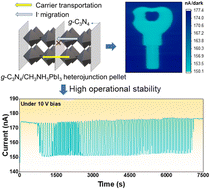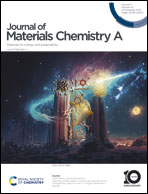Realizing low-ion-migration and highly sensitive X-ray detection by building g-C3N4 and CH3NH3PbI3 bulk heterojunction pellets†
Abstract
Three-electronic-dimensional (3D) lead halide perovskites show high X-ray sensitivities and a low limit of detection. However, servere ion migration causes dark current drift and worsens long-term operational stability. Although two-electronic-dimensional (2D) perovskite and 3D perovskite heterojunction devices have been shown to reduce ion migration, their current responses to X-rays have decreased considerably. A device with low ion migration without sacrificing X-ray sensitivity is needed. Atomic-thick two-dimensional (2D) materials with small pore sizes between atoms and high carrier-tunneling possibilities through them are reasonable candidates to simultaneously block ion migration and retain carrier–transport properties. Herein, a 2D monolayer of g-C3N4 was introduced into a CH3NH3PbI3 (MAPbI3) polycrystalline pellet through hot pressing. The small-sized tri-s-triazine structure of g-C3N4 could inhibit ion migration without affecting the electron transport of the perovskite pellet. As a result, the g-C3N4/MAPbI3 heterojunction pellet exhibited an ultra-low current drift of 4.87 × 10−5 nA cm−1 s−1 V−1 at an electric field of 12.66 V mm−1. Simultaneously, the detector exhibited a high sensitivity of 1.78 × 105 μC Gyair−1 cm−2 under 75.95 V mm−1 and a low limit of detection of 27 nGyair s−1 under 12.66 V mm−1, which are among the best of reported results. This work provides an effective design strategy to develop X-ray detectors with low ion migration and high detection performance.

- This article is part of the themed collection: 2023 Journal of Materials Chemistry A HOT Papers


 Please wait while we load your content...
Please wait while we load your content...